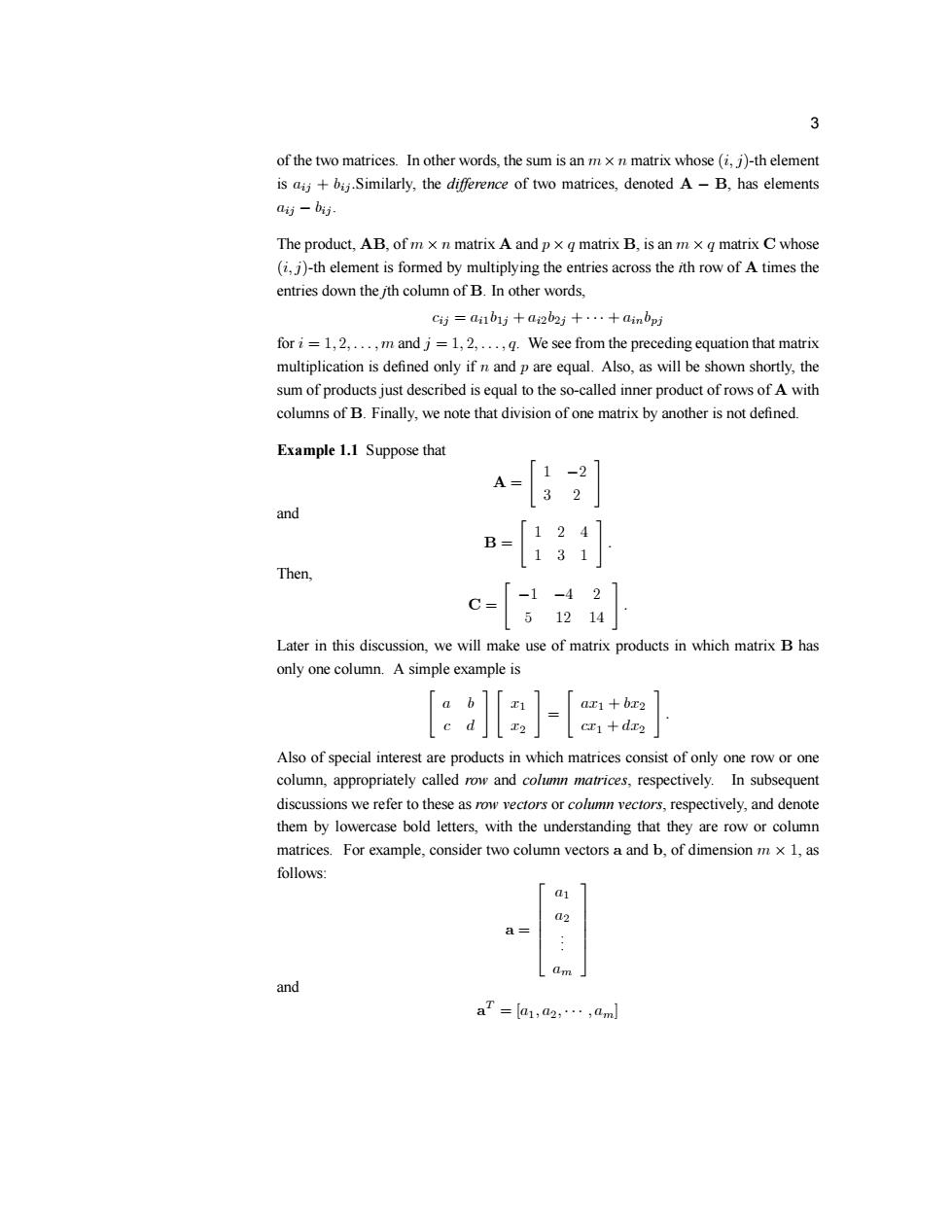正在加载图片...

3 of the two matrices.In other words,the sum is an m x n matrix whose (i,j)-th element is aij +bij.Similarly,the difference of two matrices,denoted A-B,has elements a坊-b财 The product,AB,of m x n matrix A and p x q matrix B,is an m x q matrix C whose (i,j)-th element is formed by multiplying the entries across the ith row of A times the entries down the jth column of B.In other words, C对=ai1b1j+a2b2i+…+ainbpj for i =1,2,...,m and j=1,2,...,q.We see from the preceding equation that matrix multiplication is defined only if n and p are equal.Also,as will be shown shortly,the sum of products just described is equal to the so-called inner product of rows of A with columns of B.Finally,we note that division of one matrix by another is not defined. Example 1.1 Suppose that and -(131 Then, C-3 Later in this discussion,we will make use of matrix products in which matrix B has only one column.A simple example is [:][a]-[m Also of special interest are products in which matrices consist of only one row or one column,appropriately called row and column matrices,respectively.In subsequent discussions we refer to these as row vectors or column vectors,respectively,and denote them by lowercase bold letters,with the understanding that they are row or column matrices. For example,consider two column vectors a and b,of dimension m x 1,as follows: 01 a2 a= am and aT=[a1,a2,…,am3 of the two matrices. In other words, the sum is an m£n matrix whose (i; j)-th element is aij + bij :Similarly, the difference of two matrices, denoted A ¡ B, has elements aij ¡ bij . The product, AB, of m £ n matrix A and p £ q matrix B, is an m £ q matrix C whose (i; j)-th element is formed by multiplying the entries across the ith row of A times the entries down the jth column of B. In other words, cij = ai1b1j + ai2b2j + ¢ ¢ ¢ + ainbpj for i = 1; 2; : : : ; m and j = 1; 2; : : : ; q. We see from the preceding equation that matrix multiplication is de®ned only if n and p are equal. Also, as will be shown shortly, the sum of products just described is equal to the so-called inner product of rows of A with columns of B. Finally, we note that division of one matrix by another is not de®ned. Example 1.1 Suppose that A = " 1 ¡2 3 2 # and B = " 1 2 4 1 3 1 # : Then, C = " ¡1 ¡4 2 5 12 14 # : Later in this discussion, we will make use of matrix products in which matrix B has only one column. A simple example is " a b c d # " x1 x2 # = " ax1 + bx2 cx1 + dx2 # : Also of special interest are products in which matrices consist of only one row or one column, appropriately called row and column matrices, respectively. In subsequent discussions we refer to these as row vectors or column vectors, respectively, and denote them by lowercase bold letters, with the understanding that they are row or column matrices. For example, consider two column vectors a and b, of dimension m £ 1, as follows: a = 2 6 6 6 6 4 a1 a2 . . . am 3 7 7 7 7 5 and a T = [a1; a2; ¢ ¢ ¢ ; am]